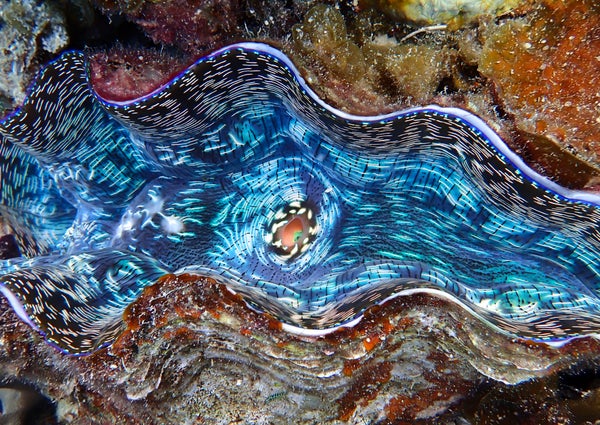In the tropical reefs off Palau, an island chain east of the Philippines, lie what at first glimpse look like unremarkable (albeit huge) shallow-water clams in the genus Tridacna. But a peek at the undulous innards tucked between their four-foot-long shells reveals sparkly blue flesh—hosting what new research shows to be the most efficient solar panels scientists have ever found.
“The fact that nobody could explain why a clam was iridescent really just stuck with me,” says Alison Sweeney, a Yale University biophysicist and co-author of the new research. In previous investigations of the distinctive sparkle, Sweeney and her colleagues determined that despite impressive iridescence, these animals’ fleshy mantles reflect as little as about 5 percent of the bright sunlight hitting them.
The rest of the incoming light is absorbed, and much of it is channeled to photosynthetic algae the clams cultivate within their bodies as a food source. Absorbing around 95 percent of incoming light is a remarkably strong basis for photosynthesis; terrestrial forests such as the Amazon, for instance, absorb less light, reducing their photosynthetic efficiency from the outset. Sweeney and her colleagues also determined that specialized cells called iridocytes, which line the mantle’s surface, contain neatly aligned stacks of transparent, protein-rich platelets that diffuse light while pushing it deeper inside the clam.
On supporting science journalism
If you're enjoying this article, consider supporting our award-winning journalism by subscribing. By purchasing a subscription you are helping to ensure the future of impactful stories about the discoveries and ideas shaping our world today.
In research published in PRX Energy, Sweeney and her team studied the arrangement of the clams’ symbiotic algae, which settle in tiny modified tubes extending up from the digestive system. The clam’s algae form a distinctive orderly pattern, arranged in thin columns that stretch from each iridocyte down into the flesh. “The clam basically plants them as if it were an agricultural field,” Sweeney says. (The algae also travel between clams in pellets of poop.)
Sweeney’s team modeled this system and calculated that its theoretical efficiency at the first step of photosynthesis, during which chlorophyll absorbs a single photon, is 43 percent—more than twice the efficiency of most current solar panels and three times that of a tropical leaf. Yet previous measurements of these clams in the wild put their comparable efficiency even higher, at more than 60 percent. In the new study, the researchers resolved this discrepancy by factoring in a quirk of clam behavior: there is evidence that clams might inflate and deflate their mantle throughout the day. This could let the clams further optimize their sunlight exposure, the scientists determined—allowing them to clock in at a modeled 67 percent efficiency.
Curious, the researchers then looked for examples of other photosynthetic systems that reflect little light and found themselves studying satellite photographs of old spruce forests. Sweeney says these images reminded her strongly of microscopic views of clam tissue. “There’s an immediate, visceral, striking resemblance if you don’t know the scale of the image you’re looking at,” she says. Like the clams’ iridocytes, which scatter light inward toward algae, these forests’ clouds and fog scatter light down to individual trees, each of which acts like a stack of algae.
Sweeney hopes this work can inform the design of algae-stocked bioreactors, in just one example of how evolution’s creative approaches to a single problem can offer inspiration for tackling technological challenges.
“Fundamental studies of biological systems give us new ideas and new strategies that can be applicable in unexpected spaces,” says Gabriela Schlau-Cohen, a physical chemist at the Massachusetts Institute of Technology, who was not involved in the new research. “Given the scale of the energy crisis, we need all the strategies we can get.”
And that means exploring the natural world far from home, says Sweeney, who grew up in the U.S. Midwest. “My sense of what photosynthesis is comes from deciduous forests and cornfields—and it turns out they’re really bad at it,” she says. “This lowly bivalve was really the right place to look for smart solutions.”
